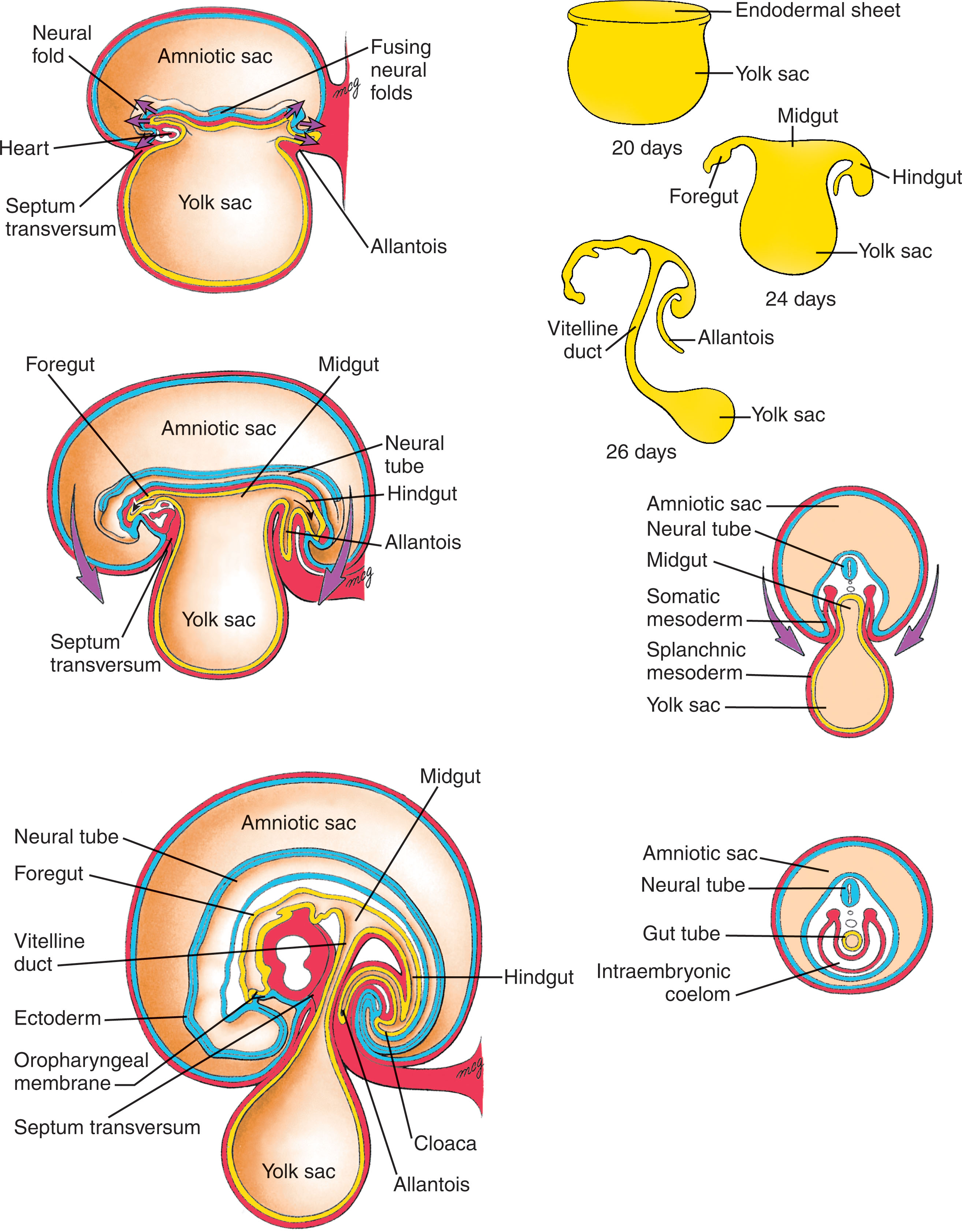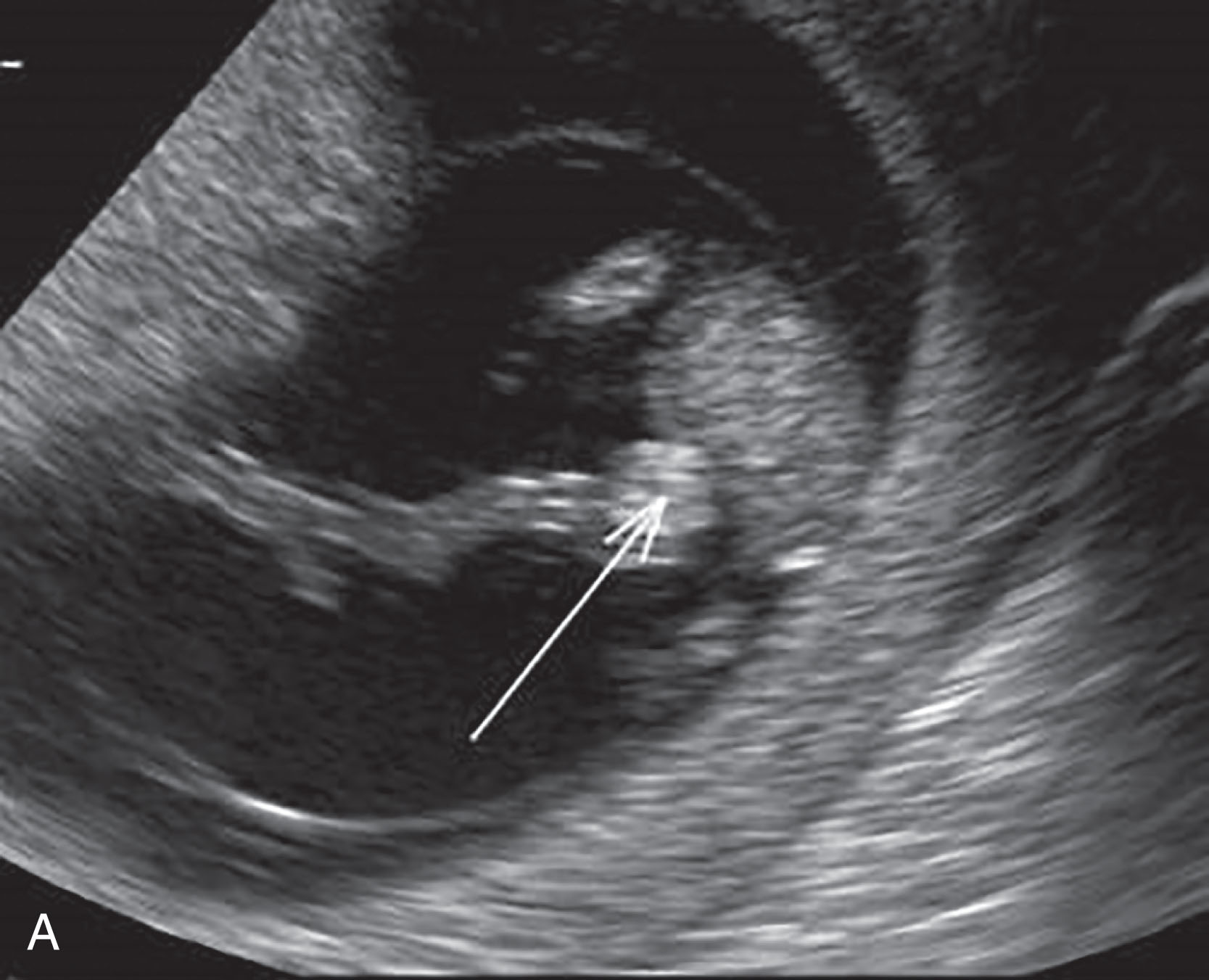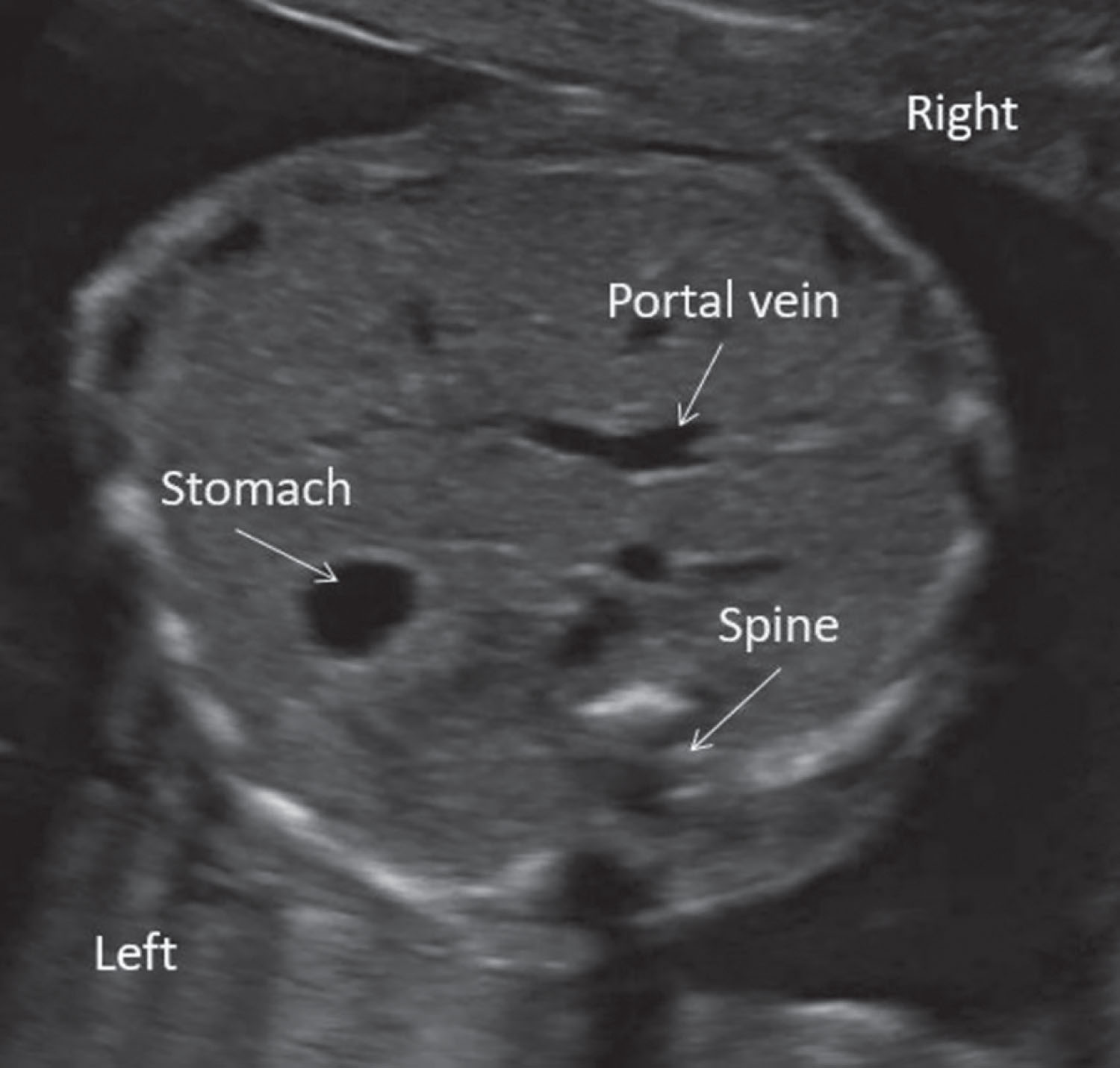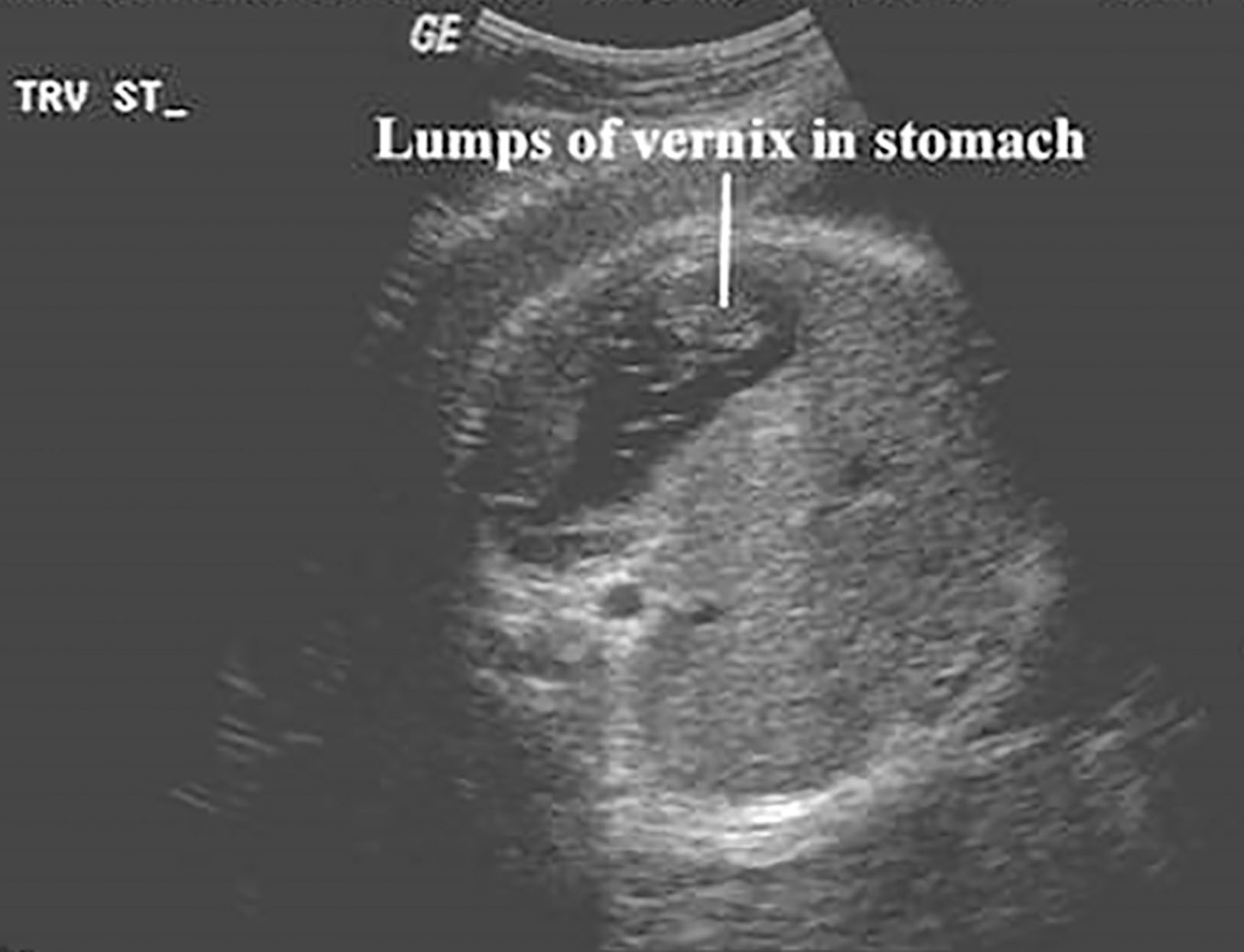Physical Address
304 North Cardinal St.
Dorchester Center, MA 02124
On completion of this chapter, you should be able to:
Describe the development of the digestive system and list the unique features of the fetal abdomen
Describe normal development of the stomach and the importance of its sonographic visualization
Define abnormalities of the fetal gastrointestinal tract and hepatobiliary system and describe their sonographic findings
The fetal abdominal organs—liver, biliary system, spleen, stomach, kidneys, and colon—are well formed by the second trimester. The following differences between the fetal and neonatal/pediatric abdomen have been noted:
The umbilical arteries and veins provide important anatomic landmarks for fetal abdominal anatomy and measurements.
The ductus venosus is patent and serves as a conduit between the portal veins and systemic veins.
The proportions of the fetal body differ from those in the pediatric abdomen. The fetal abdomen is larger relative to body length, and the liver occupies a larger volume of the fetal abdomen.
The fetal pelvic cavity is small; therefore, the urinary bladder, ovaries, and uterus lie in the abdominal cavity.
The apron of the greater omentum is small, contains little fat, and remains unfused in the fetus. Fetal ascites may therefore separate the omental leaves.
The primitive gut forms during the fourth week of gestation as the dorsal part of the yolk sac is incorporated into the embryo during folding ( Fig. 63.1 ). The primitive gut is divided into three sections: foregut, midgut, and hindgut ( Fig. 63.2 ).


The derivatives of the foregut are the pharynx, lower respiratory system, esophagus, stomach, part of the duodenum, liver and biliary apparatus, and pancreas ( Fig. 63.3 ).

The esophagus is short in the beginning, but it rapidly lengthens as the body grows, reaching its final length by the seventh week (see Fig. 63.3 ). The tracheoesophageal septum partitions the trachea from the esophagus. Esophageal atresia , usually associated with a tracheoesophageal fistula, results from abnormal deviation of the tracheoesophageal septum in a posterior direction. When this occurs, amniotic fluid cannot pass to the intestines for absorption and hydramnios results.
Esophageal stenosis is the narrowing of the esophagus, usually in the distal third portion. This occurs from incomplete recanalization of the esophagus during the eighth week of development.
The stomach appears as a fusiform dilation of the caudal part of the foregut. During the fifth and sixth weeks, the dorsal border (greater curvature) grows faster than the ventral border (lesser curvature) (see Fig. 63.3 ). The stomach is suspended from the dorsal wall of the abdominal cavity by the dorsal mesentery or dorsal mesogastrium. The dorsal mesogastrium is carried to the left during rotation of the stomach and the formation of a cavity known as the omental bursa or lesser sac of the peritoneum. The lesser sac communicates with the main peritoneal cavity or greater peritoneal sac through a small opening called the epiploic foramen.
The duodenum develops from the caudal part of the foregut and the cranial part of the midgut. The two parts grow rapidly and form a C-shaped loop that rotates to the right, where it comes to lie primarily in the retroperitoneum. The junction of the two embryonic parts of the duodenum in the adult is just distal to the entrance of the common bile duct. The duodenum is supplied by branches of the celiac trunk and the superior mesenteric artery (see Fig. 63.3 ).
During the fifth and sixth weeks, the lumen of the duodenum becomes partly or totally occluded (depending on the proliferation of its lining of epithelial cells). Normally the duodenum is recanalized by the end of the eighth week. Partial or complete failure of this process results in either duodenal stenosis (narrowing) or duodenal atresia (blockage). Usually, the third or fourth parts of the duodenal are affected.
The liver, gallbladder, and biliary ducts arise as a bud from the most caudal part of the foregut in the fourth week (see Fig. 63.3 ). The hepatic diverticulum grows between the layers of the ventral mesentery, where it rapidly enlarges and divides into two parts. The liver grows rapidly and intermingles with the vitelline and umbilical veins, divides into two parts, and fills most of the abdominal cavity. The large cranial part is the primordium of the parenchyma of the liver. The small caudal part gives rise to the gallbladder and cystic duct.
The hemopoietic cells, Kupffer cells, and connective tissue cells are derived from the mesenchyme in the septum transversum. The septum transversum is a mass of mesoderm between the pericardial cavity and the yolk stalk. It forms a major part of the diaphragm and the ventral mesentery.
Hemopoiesis (blood formation) begins during the sixth week and accounts for the large size of the liver between the seventh and ninth weeks of development. By the twelfth week, bile formation by the hepatic cells has begun.
Blockage of the bile ducts results from their failure to recanalize following the solid stage of their development. This malformation may also result from interference with the blood supply of the ducts resulting from infection during the fetal period.
The pancreas develops from the dorsal and ventral pancreatic buds of the endodermal cells that arise from the caudal part of the foregut (see Fig. 63.3 ). When the duodenum grows and rotates to the right, the ventral bud is carried dorsally and fuses with the dorsal bud. The ducts of the two pancreatic buds join. The combined duct becomes the main pancreatic duct that opens with the bile duct into the duodenum. The proximal part of the duct may persist as the accessory pancreatic duct.
The spleen is a lymphatic organ that is derived from a mass of mesenchymal cells located between the layers of the dorsal mesogastrium. The spleen is lobulated in the fetal period.
The derivatives of the midgut are the small intestines (including most of the duodenum), the cecum and cloaca exstrophy, the ascending colon, and most of the transverse colon ( Fig. 63.4 ). The superior mesenteric artery supplies all of these structures.

The midgut is suspended from the abdominal wall by an elongated dorsal mesentery. It communicates with the yolk sac via the yolk stalk. While the midgut lengthens and forms a midgut loop, it herniates outside the abdomen into the proximal part of the umbilical cord. Usually, by the 10th or 11th week, this midgut herniation returns to the abdomen and undergoes further rotation resulting from the decrease in size of the liver and kidneys and the growth of the abdominal cavity.
After the intestines return to the abdominal cavity, they enlarge, lengthen, and assume their final positions. Their mesenteries are pressed against the posterior abdominal wall. At this time, the ascending colon and descending colon become retroperitoneal. Likewise, the duodenum and most of the pancreas also become retroperitoneal structures. At the same time, the small intestines form a new line of attachment that extends from where the duodenum becomes retroperitoneal to the ileocecal junction. The mesentery of the transverse colon fuses with the dorsal mesogastrium to form the posterior wall of the inferior part of the omental bursa. The sigmoid colon retains its mesentery, but it is shorter than in the early fetus.
Omphalocele and gastroschisis are defects that occur when the midgut fails to return to the abdominal cavity from the umbilical cord during the 10th week ( Fig. 63.5 ). In an omphalocele , coils of the intestine protrude from the umbilicus and are covered by a transparent sac of amnion. The umbilical cord pierces the central part of the omphalocele. Conversely, a gastroschisis is a condition in which the bowel or organs are free floating from the midline defect. The gastroschisis is usually located to the right of the umbilical cord. (See Chapter 62 for further discussion of omphalocele and gastroschisis.)

When the intestines return, normally to the abdominal cavity and then herniate either prenatally or postnatally through an inadequately closed umbilicus, an umbilical hernia forms. The hernia differs from an omphalocele in that the protruding mass (omentum or loop of bowel) is covered by subcutaneous tissue and skin ( Fig. 63.6 ).

Meckel’s diverticulum is the most common malformation of the midgut. Meckel’s diverticulum is a remnant of the proximal part of the yolk stalk that fails to degenerate and disappear during the early fetal period. It is usually a small finger-like sac, about 5 cm long, that projects from the border of the ileum ( Fig. 63.7 ).

The derivatives of the hindgut are the left part of the transverse colon, the descending colon, the sigmoid colon, the rectum, the superior portion of the anal canal, the epithelium of the urinary bladder, and most of the urethra. The inferior mesenteric artery supplies all of these structures (see Fig. 63.2 ).
The sonographer must carefully evaluate the gastrointestinal system during the routine fetal anatomy sonographic examination. The stomach, liver, vascular structures, cord insertion, small bowel, and colon should be clearly identified.
The stomach should be identified as a fluid-filled structure in the left upper quadrant inferior to the diaphragm. A marked variation in the size of the stomach can be seen, even within the same fetus. Most fetuses older than 14 to 16 weeks should have fluid in their stomach ( Fig. 63.8 ). If no fluid is apparent, the stomach should be reevaluated in 20 to 30 minutes to rule out the possibility of a central nervous system problem (swallowing disorders), obstruction, oligohydramnios, or atresia. If fluid is still not noted during the sonographic evaluation, the fetus may be reexamined the following day or week to see if there has been a change in the size of the stomach. Esophageal anomalies are the least common problem for nonvisualization of the stomach.

The fluid within the stomach should be anechoic with linear rugae in the normal fetus. Echogenic debris may sometimes be seen along the dependent wall of the stomach that may represent vernix, protein, or intraamniotic hemorrhage ( Fig. 63.9 ). The presence of an echogenic mass in the fetal stomach in a patient who demonstrates clinical or sonographic evidence of placental abruption should raise the possibility of hematoma formation associated with an intraamniotic hemorrhage.

Although the fetal stomach is usually located on the left of the abdomen, there are conditions in which the stomach will be seen in the right upper quadrant ( situs inversus ) . The fetal position must be identified, followed by the identification of the right and left sides of the fetus. If the fetus is in a vertex presentation with the spine up, the aorta and stomach both should be seen to the left of the spine.
Become a Clinical Tree membership for Full access and enjoy Unlimited articles
If you are a member. Log in here